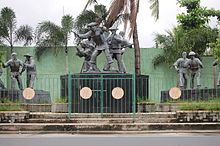Battle of Binakayan
| Battle of Binakayan-Dalahican | |||||||||
|---|---|---|---|---|---|---|---|---|---|
| Part of the Philippine Revolution | |||||||||
 Monument of the Battle of Binakayan |
|||||||||
|
|||||||||
| Belligerents | |||||||||
| Commanders and leaders | |||||||||
|
|
|
||||||||
| Strength | |||||||||
|
112,000
|
16,000-20,000
|
||||||||
| Casualties and losses | |||||||||
|
At Binakayan: 300+ deaths, ~3,000 more casualties At Dalahican: ~400-700 casualties |
At Binakayan~500+ confirmed deaths |
||||||||
Filipino Revolutionaries occupy Cavite City
112,000
16,000-20,000
At Binakayan
12,000-15,000
At Dalahican
3,000-5,000
At Binakayan~500+ confirmed deaths
(including 9 officers) ~8,000 more casualties
At Dalahican: 1,000+ casualties
The Battle of Binakayan-Dalahican was a simultaneous battle during the Philippine Revolution that was fought from November 9–11, 1896 that led to a decisive Filipino victory. The twin battle took place at the shores of Binakayan, in the town of Cavite Viejo (also called Cavite el Viejo, now Kawit); Dalahican and Dagatan in Noveleta; and, to minimal extent, in Imus and Bacoor towns in Cavite province, Philippines that lasted for two days before the Spanish army retreated demoralized and in disarray. The result of the battle was the first significant Filipino victory in the country's history.
...
Wikipedia
